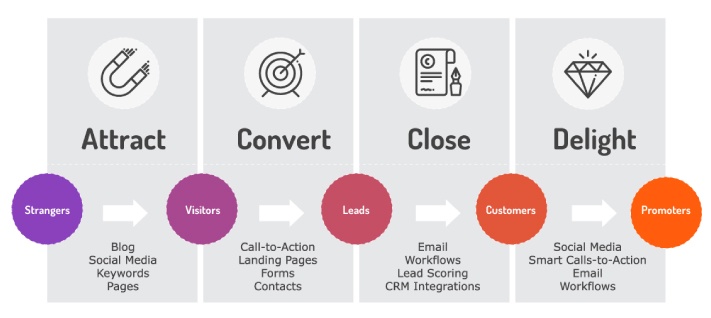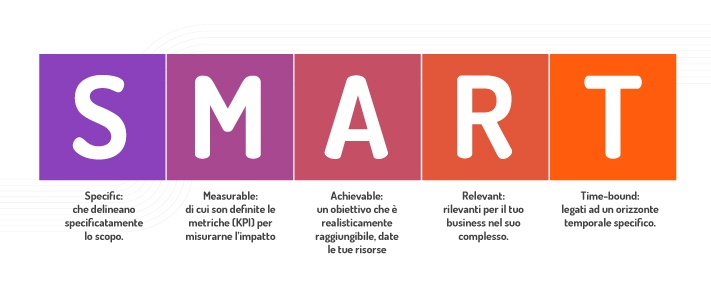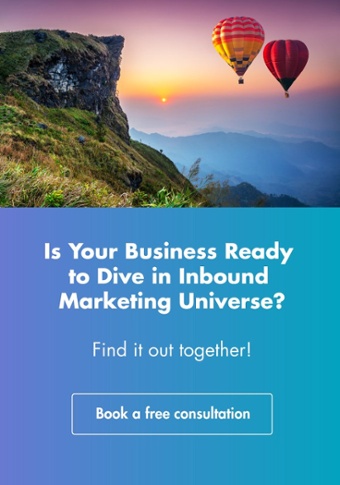It’s a fact that companies use specific software to organize many of the activities within the marketing department. From CRM, to software for email or SEO, the management of particular processes is left to more platforms presenting themselves with different logics, metrics and measurements. So, having a dialogue between the different applications becomes a strenuous task for businesses.
Adopting Marketing Automation means simplifying all these activities, while integrating and synchronizing the various technologies.
Hubspot is the Marketing Automation software that supplies, through one single platform, all the tools to manage the marketing processes, that would otherwise be divided across different technologies.
Based on the current state of the company, whether start-up, growing or in phase of acceleration, Hubspot enables automation of certain processes across the fulfillment of personalized workflows.
Let’s look in depth at how Marketing Automation works and how Hubspot can provide you with just the right solution for your business. To do this, we must go into the heart of Hubspot’s Inbound Marketing methodology.
Inbound Marketing? A case study to know the background behind this methodology
Up to now, I’ve talked about the topic of this article in quite a superficial manner. However, I’ll now tell you a story, the story of a company that has the same urgency to grow as yours does, so there’s a need to:
- attract people who are actually interested in the product;
- instill a lasting rapport with them;
- improve the rapport with existing clients.
All of these steps do nothing more than recall the methodology of Inbound Marketing:
- attract visitors, allow them to gain awareness of your company;
- convert visitors to leads or contacts, educating them on your products;
- make sure they buy and therefore go from leads to clients;
- preserve existing clients so that they continue buying from you and become testimonies of your company.
Inbound Marketing methodology:

Let’s go back to the story of the company and see how the various stages of contact between company and client are articulated. The protagonists of the story are a company that we’ll call Makeupforall and Martina, the client.
Makeupforall is a hypoallergenic cosmetics company. It has a website, blog and is present on social media, with a Facebook and Instagram page.
Martina’s story is this: due to a strong ocular allergy, she needs an eyeliner that doesn’t bring on irritation. Martina navigates the web via her smart phone, in search of a line of cosmetics that is ideal for her condition and that, in particular, has a wide range of colors. She clicks on the Google app and inserts the following keywords: “hypoallergenic eyeliner”.
Makeupforall pops up among the first results. Martina’s journey through the company website begins here.

Here we find ourselves at the first step; Makeupforall successfully attracted Martina’s attention. But what happened in this step, specifically?
- Match between the keywords in Martina’s search and those used by Makeupforall;
- Conversion from stranger to visitor (Martina has began to navigate your website);
- Martina has gained awareness regarding the company. In short, Makeupforall has what she’s looking for.
At the attraction stage, the key tools and process for a company are:
- SEO optimization (site, blog);
- Content marketing;
- Promotion of content on social media.
Martina’s journey through Makeupforall’s website continues until she arrives at a page where she sees a button reading: “Discover our solutions based on your allergy”. Martina clicks on the button and is then asked to fill out a form
We’re now at the second step: conversion. Martina has gone from visitor to lead, or a contact Makeupforall can work on.
At the conversion stage, the main tools are:
- Form (the one Martina had to fill out to be able to download the brochure);
- CTA (Call to Action: the “discover our solutions based on your allergy” button);
- Premium Content & Landing pages (the brochure Martin downloaded).
Martina reads the brochure and finds it interesting. She’s finally found someone who explains why certain colors cause allergic reactions and other don’t. Therefore, she begins to trust the company.
Straight after registering, Martina receives a welcome-email from Makeupforall. After a day or two, she starts to receive emails with content that appeals to her on the various types of allergies and on the manufacturing of the products.
This action on behalf of Makeupforall is called Lead Nurturing, or contact nurturing: Martina is nourished with contents that she finds extremely interesting.

We find ourselves at the third stage of Inbound Marketing: closure. The following tools are necessary in this phase:
- CRM (database in which all info of leads is collected);
- Email marketing;
- Lead Nurturing;
After a couple of emails, Martina’s ready for purchase and buys.
Is the rapport now concluded? Everybody satisfied? No way. It would be silly to stop here. Indeed, the company’s well aware of this and follows up with an email a few days later. It reads: “Thank you for your purchase. Do you mind sharing how you found us?”
Martina’s birthday then arrives after a couple of months; the e-commerce is ready with its “happy birthday” email that also includes a good discount. There are social media icons in the email through which Martina logs in to the company webpage, clicks “like”, starts sharing the company’s products on social media and becomes Ambassador.
“Choosing the HubSpot plan that suits you better is not so easy, we know. But, there’s a trick you can use to get the best marketing automation software.” Tweet
We’ve now arrived at the final stage; Martina’s now a promoter.
At this stage, in which the company delights the client and creates a sense of loyalty, making the client a testimony for your brand, the fundamental tools at hand are:
- Satisfaction-surveys;
- Smart content;
- Monitoring social media.
Let’s now analyze what kind of software Makeupforall had to use in every stage of contact with Martina:
- Tools for SEO optimization;
- Tools to define Prospective Buyers;
- CMS to manage contents;
- Email-marketing-software;
- CRM, or database of contacts.
This kind of approach usually doesn’t come out on top, as it’s difficult to make different technologies dialogue with one another, including data collection and measurements.

This is where marketing automation comes into play as a solution for synchronizing different technologies. How?
- It organizes and simplifies processes, specific activities;
- Integrates marketing solutions by making them dialogue with one another (no longer a thousand pieces of data on a thousand different platforms);
- Increases effectiveness of advertising campaigns orientated towards performance and ROI;
- Improves visitor’s user experience with interesting content.
What is your company’s objective? Build, Grow, Accelerate? Discover it now with us!
Before diving into the world of Marketing Automation, the following factors must be clear:
- The objectives that must be reached;
- The strategy to be put in place.
In fact, based on the particular business objectives, Hubspot provides different plans, across specific tools, that enable you to reach the finish line, with everything bound in a single platform, instead of being partitioned. Thus, no longer a thousand different types of software to manage and countless spreadsheets to pile together and study, but rather a single path in which measuring up the client is easy, along with being able to create targeted and personalized campaigns.
To simplify things, we’ve identified three fundamental moments in the life of a company that uses various tools:
Build: the company starts from scratch, from creating the foundations. Hubspot’s plan foresees the following main activities:
- On-page SEO (for website);
- Development of prospective buyers;
- Keyword research;
- Blogging;
Grow: this company needs to develop its resources and, in this case, the main processes with which it will operate are the following:
- Social media publishing to increase traffic;
- Offers of premium content & landing pages;
- Promotional offers;
- Developing the route of dialogue.
Accelerate: it’s in a phase of needing to accelerate its results and therefore definitely needs:
- Social media ads
- Database management;
- Segmentation;
- Implementation of CRM;
Now it’s your turn! What are the objectives you want to reach? What software/s do you currently use to run your company? After this brief overview, you should already have an idea of which Hubspot-solutions best suit your situation.
Discover which Hubspot-tool suits you. Book a free consultation!

